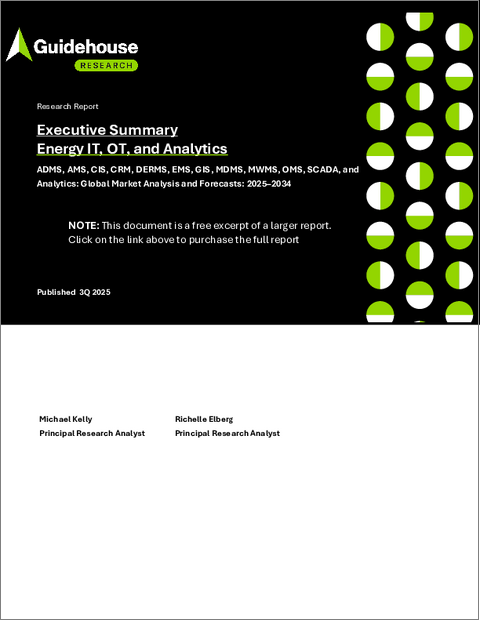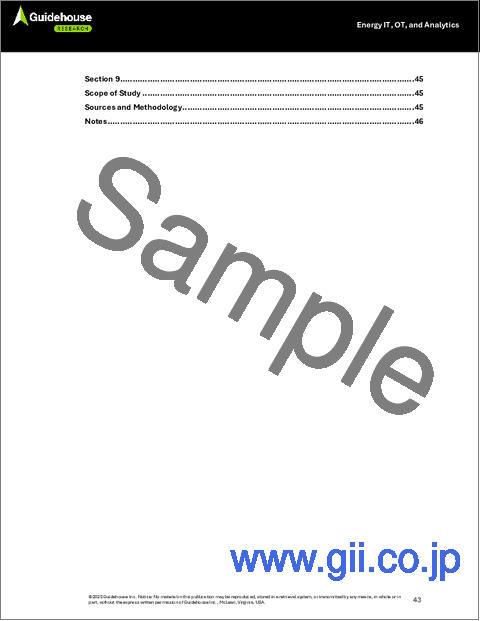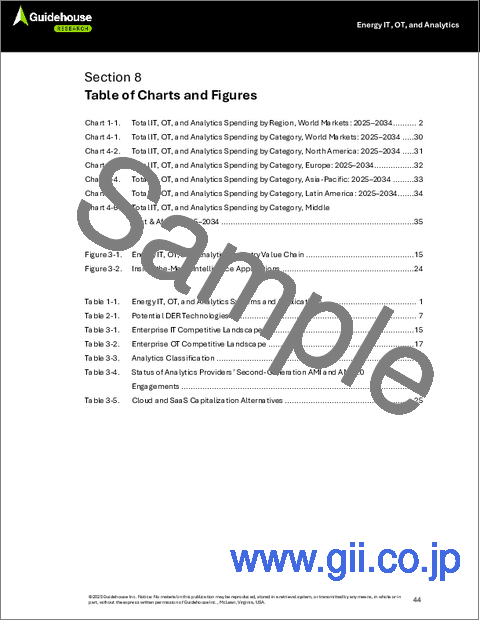|
|
市場調査レポート
商品コード
1773188
エネルギーIT・OT・アナリティクス (ADMS・AMS・CIS・CRM・DERMS・EMS・GIS・MDMS・MWMS・OMS・SCADA・アナリティクス):世界市場の分析・予測 (2025-2034年)Energy IT, OT, and Analytics - ADMS, AMS, CIS, CRM, DERMS, EMS, GIS, MDMS, MWMS, OMS, SCADA, and Analytics: Global Market Analysis and Forecasts, 2025-2034 |
||||||
|
|||||||
| エネルギーIT・OT・アナリティクス (ADMS・AMS・CIS・CRM・DERMS・EMS・GIS・MDMS・MWMS・OMS・SCADA・アナリティクス):世界市場の分析・予測 (2025-2034年) |
|
出版日: 2025年07月18日
発行: Guidehouse Research
ページ情報: 英文 47 Pages
納期: 即納可能
|
全表示
- 概要
- 図表
- 目次
電力会社がデジタルトランスフォーメーションを推進する中で、エンタープライズIT、運用技術 (OT)、エネルギーアナリティクスの融合が、インフラ管理、顧客対応、将来計画のあり方を大きく変えつつあります。
本レポートは、ADMS (高度配電管理システム)、DERMS (分散エネルギー資源管理システム)、CIS (顧客情報システム)、SCADA (監視制御およびデータ収集システム) など12の主要なITおよびOTシステムと、14のエネルギー分析アプリケーションを対象に、世界市場の包括的な分析を提供しています。電力会社がこれらの技術を活用して電力網の信頼性向上、業務最適化、顧客ニーズへの対応を図っている様子が詳述されています。
また、本レポートでは、分散型エネルギー資源の拡大、電力料金の上昇、第2世代スマートメーターの登場 (エッジ分析機能搭載) など、主要な市場推進要因を取り上げています。さらに、モジュール型で相互運用可能なソフトウェアアーキテクチャや柔軟な価格モデルへの移行、さらに顧客満足度の向上と規制遵守の重要性の高まりにも焦点を当てています。一方で、データのサイロ化、サイバーセキュリティの懸念、レガシーシステムの制約といった障壁についても言及されており、それらを克服するための戦略も提示されています。
本レポートには、5つの地域、12のITおよびOTシステム、14のアナリティクス用途、4つの支出カテゴリー (ソフトウェアライセンス費、導入・統合サービス、年間保守費、クラウドおよびSaaS利用料) に分けた今後10年間の世界市場予測も含まれています。
目次
第1章 エグゼクティブサマリー
第2章 市場動向
- エネルギーITとOTの概要
- エネルギーアナリティクスの概要
- 市場促進要因
- ソフトウェアアーキテクチャの進化
- DERの成長
- ピーク需要
- 電力コストと請求額の上昇
- 顧客満足度
- 価値の積み上げ
- 次世代スマートメーター
- レガシーCISの制限
- 市場の障壁
- コストと複雑さ
- 競争の激しい市場
- 既存のデータのサイロ化
- データの品質不良
- 資本化に関する制約
- サイバーセキュリティ
- 消費者のプライバシー
- 通信要件
第3章 産業バリューチェーン
- 競合情勢
- エンタープライズIT
- エンタープライズOT
- エネルギーアナリティクス
- ビジネスモデルの進化
- エンドツーエンドのプラットフォームプレイ
- データ統合
- 価格モデルの革新
- 次世代AMI
- TOUと複合レート
- クラウドとSaaS
- 新規顧客市場とセグメント
第4章 市場予測
- 予測手法
- 世界市場の予測
- 地域市場の予測
- 北米
- 欧州
- アジア太平洋
- ラテンアメリカ
- 中東・アフリカ
第5章 結論・提言
- 3つの大きなポイント
- 推奨事項
第6章 頭字語と略語一覧
第7章 目次
第8章 図表
第9章 範囲、情報源、調査手法と注記
List of Tables
- Table 1-1. Energy IT, OT, and Analytics Systems and Applications
- Table 2-1. Potential DER Technologies
- Table 3-1. Enterprise IT Competitive Landscape
- Table 3-2. Enterprise OT Competitive Landscape
- Table 3-3. Analytics Classification
- Table 3-4. Status of Analytics Providers' Second-Generation AMI and AMI 2.0 Engagements
- Table 3-5. Cloud and SaaS Capitalization Alternatives
List of Figures
- Chart 1-1. Total IT, OT, and Analytics Spending by Region, World Markets: 2025-2034
- Chart 4-1. Total IT, OT, and Analytics Spending by Category, World Markets: 2025-2034
- Chart 4-2. Total IT, OT, and Analytics Spending by Category, North America: 2025-2034
- Chart 4-3. Total IT, OT, and Analytics Spending by Category, Europe: 2025-2034
- Chart 4-4. Total IT, OT, and Analytics Spending by Category, Asia-Pacific: 2025-2034
- Chart 4-5. Total IT, OT, and Analytics Spending by Category, Latin America: 2025-2034
- Chart 4-6. Total IT, OT, and Analytics Spending by Category, Middle East & Africa: 2025-2034
- Figure 3-1. Energy IT, OT, and Analytics Industry Value Chain
- Figure 3-2. Inside-the-Meter Intelligence Applications
As electric utilities pursue digital transformation, the convergence of enterprise IT, operational technology (OT), and energy analytics is reshaping how they manage infrastructure, engage customers, and plan for the future. This Guidehouse Research report provides a comprehensive analysis of the global market for 12 core IT and OT systems-including ADMS, DERMS, CIS, and SCADA-and 14 energy analytics applications. It explores how utilities are leveraging these technologies to improve grid reliability, optimize operations, and respond to evolving customer expectations.
The report examines key market drivers such as the growth of distributed energy resources, rising electricity costs, and the emergence of second-generation smart meters with embedded edge analytics. It also highlights the shift toward modular, interoperable software architectures and flexible pricing models, as well as the growing importance of customer satisfaction and regulatory alignment. Barriers such as data silos, cybersecurity concerns, and legacy system limitations are also addressed, alongside strategies for overcoming them.
The report includes 10-year global forecasts segmented by five regions, 12 IT and OT systems, 14 analytics applications, and four spending categories: software license fees, implementation and integration services, annual maintenance, and cloud and software-as-a-service fees.
Table of Contents
1. Executive Summary
- 1.1 Introduction
- 1.2 Report Scope
- 1.3 Global Forecast
2. Market Trends
- 2.1 Introduction
- 2.2 Energy IT and OT Overview
- 2.3 Energy Analytics Overview
- 2.4 Market Drivers
- 2.4.1 Evolution of Software Architectures
- 2.4.2 Growth in DER
- 2.4.3 Peak Demand
- 2.4.4 Escalating Electricity Costs and Bills
- 2.4.5 Customer Satisfaction
- 2.4.6 Value Stacking
- 2.4.7 Next-Generation Smart Metering
- 2.4.8 Legacy CIS Limitations
- 2.5 Market Barriers
- 2.5.1 Cost and Complexity
- 2.5.2 Competitive Market
- 2.5.3 Existing Data Silos
- 2.5.4 Poor Data Quality
- 2.5.5 Capitalization Restrictions
- 2.5.6 Cybersecurity
- 2.5.7 Consumer Privacy
- 2.5.8 Communications Requirements
3. Industry Value Chain
- 3.1 Competitive Landscape
- 3.1.1 Enterprise IT
- 3.1.2 Enterprise OT
- 3.1.3 Energy Analytics
- 3.2 Business Model Evolution
- 3.2.1 End-to-End Platform Plays
- 3.2.2 Data Unification
- 3.2.3 Pricing Model Innovations
- 3.2.4 Next-Generation AMI
- 3.2.5 TOU and Complex Rates
- 3.2.6 Cloud and SaaS
- 3.2.6.1 Eroding Regulatory Barriers
- 3.2.7 New Customer Markets and Segments
4. Market Forecasts
- 4.1 Introduction
- 4.2 Forecast Methodology
- 4.3 Global Forecast
- 4.4 Regional Forecasts
- 4.4.1 North America
- 4.4.2 Europe
- 4.4.3 Asia-Pacific
- 4.4.4 Latin America
- 4.4.5 Middle East & Africa
5. Conclusions and Recommendations
- 5.1 Three Big Takeaways
- 5.2 Recommendations





